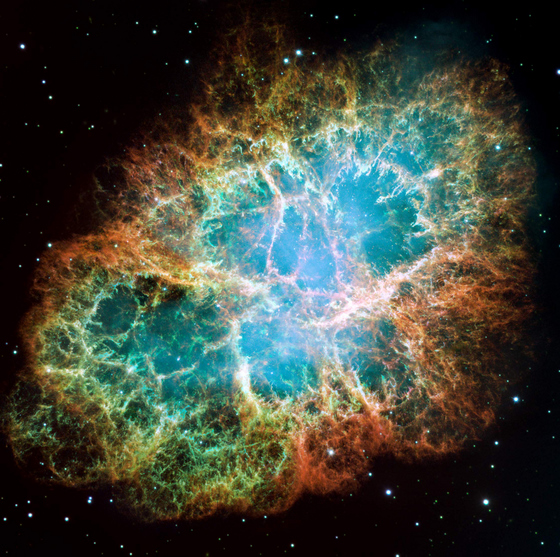[/caption]
Scientists studying the
Crab Nebula
have discovered high energy gamma rays around the rotation-powered pulsar, the neutron star at the center of this enigmatic nebula. Neutron stars accelerate particles to immense energies, typically one hundred times more than the most powerful accelerators on Earth. Scientists have been uncertain exactly how these systems work and where the particles are accelerated. But by using the gamma-ray telescope on the European Space Agency's INTEGRAL spacecraft orbiting Earth, astronomers have detected polarized gamma-rays emitting from near the pulsar.
The Crab Nebula was created by a supernova explosion which was seen from Earth by early Chinese and Arab astronomers on July 4, 1054. The explosion left behind a pulsar or rotating neutron star with a nebula of radiating particles around it. [caption id="attachment_17455" align="alignnone" width="250" caption="The Crab Pulsar. This image combines optical data from Hubble (in red) and X-ray images from Chandra X-ray Observatory (in blue)."]
[/caption]
The neutron star contains the mass of the Sun squeezed into a volume of about 10 km radius, rotating very fast - about 30 times a second - thereby generating magnetic fields and accelerating particles. But until now, astronomers didn't know exactly where the particles were accelerated.
Looking into the heart of the pulsar with Integral’s spectrometer (SPI), the researchers made a detailed study of over 600 observations to assess the polarization â€" or the alignment - of the waves of high-energy radiation originating from the Crab.
They saw that this polarized radiation is aligned with the rotation axis of the pulsar. So they concluded that a significant portion of the electrons generating the high-energy radiation must originate from a highly-organized structure located very close to the pulsar, very likely directly from the jets themselves. The discovery allows the researchers to discard other theories that locate the origin of this radiation further away from the pulsar. [caption id="attachment_17456" align="alignnone" width="250" caption="Credits: NASA/CXC/ASU/J. Hester et al.(for the Chandra image); NASA/HST/ASU/J. Hester et al. (for the Hubble image) "]
[/caption]
Professor Tony Dean of the University’s School of Physics and Astronomy, and one of the researchers, commented that the discovery of such alignment â€" also matching with the polarization observed in the visible band - is truly remarkable. “The findings have clear implications on many aspects of high energy accelerators such as the Crab,†he added.
"The detection of polarized radiation in space is very complicated and rare, as it requires dedicated instrumentation and an in-depth analysis of very complex dataâ€, said Chris Winkler, Integral Project Scientist at ESA.
The paper 'Polarized gamma-ray emission from the Crab' is published this week in Science.
More information about the
Integral Spacecraft.
Sources:
ESA
 Universe Today
Universe Today
